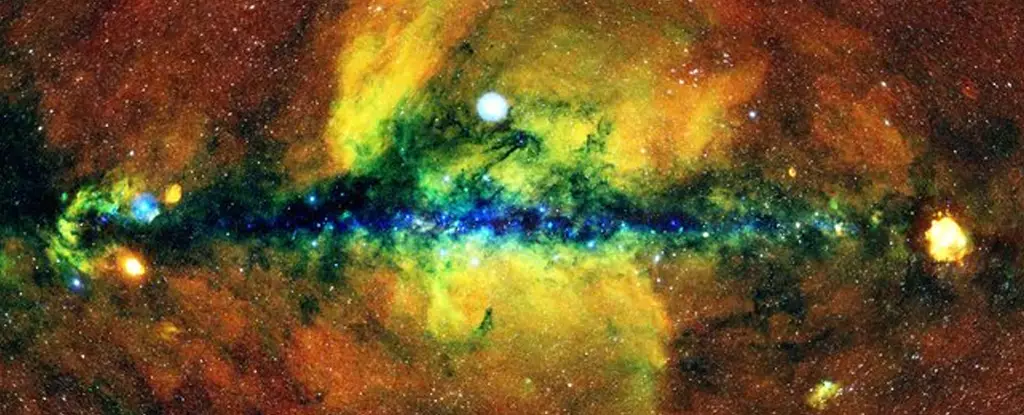In the realm of science fiction, the concept of X-ray vision has long captivated the imagination of readers and viewers. While possessing this ability may be a physical impossibility, astronomers have found a remarkable workaround that allows us to explore the cosmos with X-ray vision. X-ray astronomy, a field that has been in existence for six decades, offers a unique window into some of the most energetic and violent events and objects in the universe. From bright quasars and supernova explosions to hot gas streams between galaxies and young, scorching stars, X-ray astronomy unveils the hidden mysteries of our celestial surroundings. Recently, the eROSITA consortium at the Max Planck Institute for Extraterrestrial Physics announced an astounding breakthrough in X-ray astronomy, sharing a trove of data from the eROSITA survey. This cutting-edge survey covers half the X-ray sky and provides unprecedented insights into 900,000 distinct X-ray sources. With this groundbreaking accomplishment, astronomers have surpassed all previous records in X-ray astronomy, including those achieved by renowned observatories like Chandra and XMM-Newton.
Exploring the Universe in X-Rays
X-ray astronomy revives our understanding of hot and energetic celestial objects and events. It directs its focus towards the cores of galaxies, where supermassive black holes reside, as well as supernova explosions, newborn stars, and other regions where matter experiences extreme temperatures. The initial data set from the eROSITA survey, known as eRASS1, identifies approximately 710,000 supermassive black holes, 180,000 X-ray-emitting stars within the Milky Way, and 12,000 galaxy clusters. Moreover, it sheds light on a limited number of intriguing phenomena, such as X-ray-emitting binary stars, supernova remnants, pulsars, and other enigmatic objects. These mind-blowing numbers emphasize the exceptional capabilities of X-ray astronomy, surpassing the achievements of flagship missions like Chandra and XMM-Newton, which have accumulated their data over a span of nearly 25 years. According to Andrea Merloni, the eROSITA principal investigator, the ground-breaking discoveries made within just six months demonstrate the tremendous potential of these pioneering observations.
The release of the eROSITA first data marks a significant milestone in X-ray astronomy. The extensive data set provides a “multi-layered” view of the sky at different X-ray energies, each offering unique insights into the objects and events that emit X-rays. The eROSITA consortium accompanies this wealth of images and data with additional information, including lists of source classes, sky positions, energies, and precise arrival times of photons to the instrument. With a focus on ensuring the highest quality data and software release, Miriam Ramos-Ceja, the leader of the eROSITA Operations team, expresses hopes of broadening the global community of scientists working with high-energy data and driving the frontiers of X-ray astronomy.
The eROSITA X-ray telescope aims to achieve numerous scientific objectives by exploiting X-rays as a medium for detecting the hot intergalactic medium within 50 to 100,000 galaxy clusters and groups. Additionally, it examines hot gas present in filaments connecting these clusters, which emit X-rays. Another key goal of eROSITA involves the identification of accreting black holes concealed within galaxies. Furthermore, it investigates the physics of galactic X-ray sources encompassing pre-main-sequence stars, supernova remnants, and X-ray binaries. A recent paper utilizing data from the new survey focuses on leveraging X-ray data to discern cosmological models through the analysis of galaxy clusters. One intriguing image from the survey captures a newly discovered filament of material stretching between the galaxy clusters Abell 3667 and Abell 3651. This discovery holds the potential to provide invaluable insights into the composition of the “warm-hot intergalactic medium” and its impact on the development of large-scale structures, such as galaxy clusters, in our universe. Another prominent feature in the eRASS1 survey is the nearby Virgo Cluster of galaxies, which serves as a captivating focal point for studying large-scale filamentary structures.
Unlocking the Mysteries
The new survey data, combined with existing all-sky images, has enabled a scientific team to explore the intricate structures present in the outskirts of the Virgo Cluster. By examining high-energy emissions surrounding galaxies and groups within the cluster, researchers aim to comprehend the physical processes governing these colossal galaxy clusters’ periphery. Notably, the team has also investigated a “X-ray extension” nearing 320 kiloparsecs close to the galaxy M49. Through the launch of eROSITA, X-ray astronomy has taken a tremendous leap forward, providing high-resolution X-ray vision of the cosmos since its inception in June 2019. While intently scanning the sky, eROSITA identified fascinating changes within a distant quasar by the name of SMSS J114447.77-430859.3. These variations shed light on the black hole’s growth at the center of the quasar, as well as the consumption of stray material falling into its event horizon and the outward escape of powerful winds. Significantly, the instrument also detected the formation of a new black hole in the early universe and mapped the presence of hot gas surrounding our own Milky Way Galaxy. As the technicians assess and ensure the instrument’s wellbeing in its current safe mode, eROSITA prepares to embark on even more groundbreaking discoveries in the field of X-ray astronomy.
X-ray astronomy has unlocked an entirely new perspective for astronomers, allowing them to witness the universe through X-ray vision. The eROSITA survey represents a pivotal moment in this revolutionary field, providing unprecedented insights into our cosmic environment. With its vast data set and high-quality software release, eROSITA continues to push the boundaries of X-ray astronomy and opens the doors to further exploration and discovery. As we delve deeper into the mysteries of the universe, X-ray astronomy will undoubtedly play a key role in unraveling its enigmatic secrets.


Leave a Reply